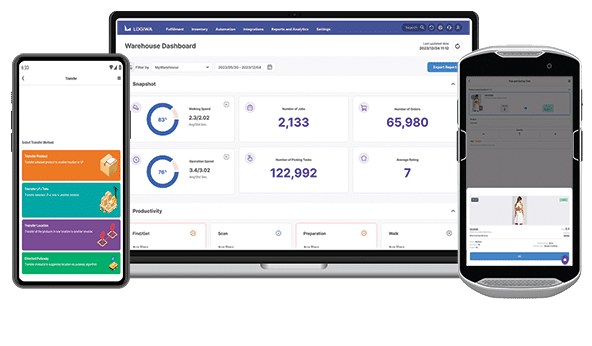In the world of ecommerce, being able to meet demand is the ultimate test for online retailers. Luckily, inventory forecasting acts as a secret sauce for navigating supply and demand.
Enhancing your inventory forecasting can lead to major gains, so long as you have the right approach. In this guide, we will explain key forecasting strategies and tips for boosting your online success.
Contents
Key Takeaways
- Inventory forecasting helps meet consumer demand and adapt to changing DTC conditions.
- Forecasting helps maximize profits by optimizing stock levels, pricing structures, and warehouse efficiency.
- Four primary methods include: qualitative, time-series, causal and machine learning and AI.
- Forecasting requires multiple approaches, such as real-time data tracking, the use of analytics, and collaboration with suppliers.
- Using accurate data, external factors and leading technology are a competitive advantage.
Why Inventory Forecasting Matters for Online Retailers
Meeting consumer expectations can make or break your online retail business. Standards like same-day delivery make staying ahead of the customer needs more important than ever.
Speed and precision are key to attracting consumers and positive deliveries. Inventory forecasting plays a key role setting you up for success. It does this by predicting future demand.
Forecasting uses data to ensure you have the right products available at the right time. When done correctly, you can satisfy buyers, optimize supply chains and offer agile fulfillment. This keeps you competitive as more retailers expand their online presence.
The Power of Inventory Forecasting In Action
As an online retailer, you know how important it is to keep customers. Inventory forecasting helps you please customers and build a healthy brand reputation. It drives repeat business and growth. Without knowing what lies ahead, you risk major setbacks that affect your entire operation.
Here are the top reasons you need to perfect inventory forecasting.
Meeting Customer Demand
Online retail has changed consumer expectations. Delays are no longer an option. Shoppers expect a flawless shopping experience, from placing an order to doorstep delivery. Inventory forecasting ensures you have the right products available when customers want them.
Avoiding Stockouts and Overstock Situations
Stockouts cause you to lose sales, customers, and consumer confidence in your brand. On the flip side, overstock can incur significant costs. Inventory forecasting helps you maintain a balance between supply and demand. Keeping your stock levels synced with real demand helps avoid overstock and stockouts.
Reducing Costs and Maximizing Profits
Having too much inventory can quickly eat into your profits. It increases your storage and insurance costs, including warehouse rental, utilities, and labor. Inventory forecasting reduces these expenses by making sure you only stock what you need. It helps you use only the necessary amount of resources.
Improving Pricing Strategies
With accurate inventory forecasts, you can offer better pricing strategies. When demand is high and supply is low, you can increase prices to maximize profits. During slow periods, you can offer discounts to boost sales. This helps manage costs and demand at the same time.
Enhancing Efficiency
Fast, accurate order fulfillment is the path to satisfied customers. Inventory forecasting helps you know which products will be in demand and have them ready to ship. This allows you to speed up the order fulfillment process. This promotes standards like same-day shipping and same-day delivery.
Streamlining the Supply Chain
Inventory forecasting also plays a crucial role in supply chain management. It enables you to communicate with suppliers effectively, ensuring a smooth flow of inventory to meet customer demands.

4 Types of Inventory Forecasting
Inventory forecasting comes in a variety of forms to meet different needs. Each of these methods rely on market research, historical data, and the effect marketing spend has on sales. Consider these flexible forecasting options for your specific circumstances.
Inventory forecasting includes:
- Qualitative forecasting relies on expert opinions and market research to predict demand. These methods can be useful for understanding customer preferences and trends.
- Time-series forecasting uses historical data to forecast future demand. This means taking using past values to predict future values. It can includes averages, exponential trends, and finding patterns and trends.
- Causal forecasting looks at how your marketing tactics will affect sales. It focuses on cause-and-effect.
- Machine learning and AI are leading inventory forecasting tools. They use historical data and smart formulas to make precise predictions.
For an in-depth look on each of these methods, check out Logiwa’s blog, “Demand Forecasting & Demand Planning for Higher Retail Profit Margins.”
The Secret to Optimizing Inventory Forecasting Methods
Now, let’s explore the best methods and practices for online retailers to master inventory forecasting:
Real-Time Data Tracking
Real-time data is one of the most effective inventory forecasting methods. It provides instant clarity into sales, stock levels, and demand. Using inventory tracking software and warehouse technology offers live data insights. This helps you gauge demand, reordering needs and more.
Inventory Management Software
Inventory management tools are part of different types of software. These tools not only provide real-time data but also BI tools. This allows you to forecast effectively. It also helps you automate your supply chain and streamline the fulfillment process.
Reviewing Historical Data
Analyzing past sales, demand trends and seasonal shifts from historical data is a must. By understanding how your products have sold in the past, you can make highly accurate forecasts. Seasonal products or shifts in consumer behavior will impact your inventory needs.
Customer Segmentation and Behavior Analytics
Changing your inventory strategy to consider different types of customers can enhance forecasting accuracy. Breaking your customers down into groups can lead to important insights in buying behavior. This helps you predict preferences and needs across your buyers.
Predictive Analytics and Demand Forecasting
Predictive analytics can teach you what to expect from consumers. Using machine learning and AI ensures data-driven decision-making. These models consider a wide range of factors to make accurate predictions and meet demand.
Collaborative Forecasting
Working with your suppliers and partners can improve forecasting. By sharing data and insights, you can work together to ensure your inventory aligns with market demand. Talking to your suppliers and partners leads to valuable insights on sales, promotions, and market trends.
Safety Stock and Reorder Point
Safety stock keeps you from running out of stock during sudden spikes in demand or supply chain changes. You can calculate safety stock levels based on historical data. Reorder points make sure you restock when inventory levels drop to a certain level. This is vital for maintaining the right types and amounts of items.
Efficient Allocation of Resources
Using an ABC strategy sorts inventory items based on their value and demand. A-items represent high value and demand. These types of items will need to receive more attention than C-items, which are lower in value or demand. This allows you to focus your efforts and resources where they matter most.
How to Overcome Inventory Forecasting Challenges
Inventory forecasting isn’t without its challenges. Here are Logiwa’s tips for improving your overall strategy:
- Use accurate data. Accurate forecasting relies on quality data. Inaccurate or incomplete data will lead to incorrect predictions. Make sure your data is dependable from the start.
- Take seasonal trends into account. Seasonal products and rapidly evolving trends can disrupt forecasting accuracy. Take the time to understand what trends are happening during certain times of the year. This is even more important during peak seasons.
- Evaluate external factors. Economic conditions, international events, and other factors can impact demand in surprising ways. Stay updated on real-world news in addition to digital trends.
- Refine your forecasting approach. No method is perfect all on its own. There will always be some degree of error. Monitoring and refining your models over time is crucial.
- Use advanced technology as often as possible. Outdated software or lack of advanced tools can limit the results of your forecasting efforts. Invest in the best solutions to ensure the best results.
- Adopt modern fulfillment management solutions. Having the right software is essential. Ensure your software solutions enhance your business. They should unify your data and offer forecasting functions.
Inventory forecasting isn’t just a business strategy. It gives you a competitive edge in the online retail world. The secret to successful inventory forecasting lies in combining methods and tailoring them for your business.
Inventory Forecasting Software for Online Retailers
Using inventory forecasting software makes things a lot easier for online retailers and their warehouse operations. Today’s fulfillment solutions include features that assist with demand predictions. They optimize warehouse inventory and shipping operations.
Logiwa provides tools to help you anticipate customer needs and keep the right products in stock. Our fulfillment management system includes analytics and reporting to help boost profits and grow efficiencies.
The secret to enhancing customer satisfaction and securing your place in the ecommerce world requires the right solution. Unlock the power of inventory forecasting and propel your business toward success. Request a demo of Logiwa WMS today.
FAQs Related to Inventory Forecasting
Why is inventory forecasting important for online retailers?
Forecasting is key for online retailers because it helps predict what products customers will want in the future. This means ensuring they have the right amount of stock to avoid shortages or excess, which saves money and pleases customers. It promotes agility in an ever-changing market.
What are some common methods for inventory forecasting?
Common methods for forecasting include using historical data and looking at past demand patterns. It includes using models like moving averages or regression analytics. Some retailers also use advanced technologies like artificial intelligence and machine learning for more accurate predictions.
How can online retailers improve their inventory forecasting?
Online retailers can improve inventory forecasting by using real-time data tracking tools. Analyzing customer behavior and working with suppliers also enhances forecasting. Regularly review and update forecasting methods to adapt to changing market conditions.
Manage All Your Warehouse Operation Easily With Our Digital Warehouse and Fulfillment System
Warehouse Management
Modern digital WMS powers a modern fulfillment experience





